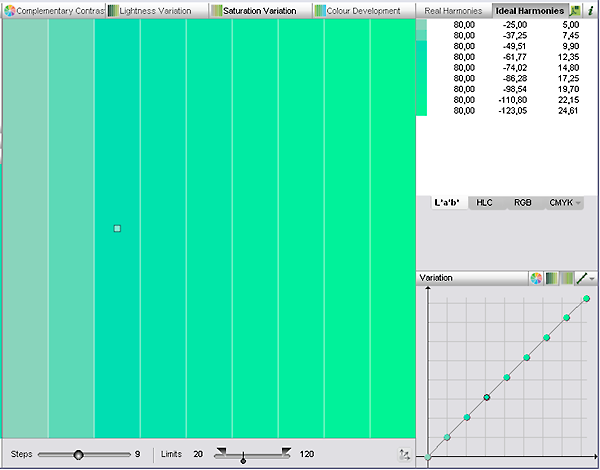Colour Harmony · Saturation Variation
How do I apply a colour with more or less intensity?Vernacular says "Birds of a feather flock together"
With the function "Saturation variation" you'll answer these questions not only generally but also for each colour system: Which blue hue is more vivid than dove blue?
With several different grades of the saturation variation you will obtain a colour development that culminates in the same basic statement at its maximum intensity – a heightening, it absolutely has a certain inherent dramatic.

In painting a lot of experience is needed in order to vary the colour intensity. At the computer all it takes is pushing a button.
The saturation variation is also referred to as the “saturation contrast” or “pure-dull contrast” in the literature. We prefer the term “variation” as the results do not contrast with each other, but rather lie next to each other, variations on a theme.
Brief Instruction
- Select „Colour harmony“ and the third button of the harmony variants.
- Choose the starting colour of the harmony calculation. Either by entering colour values or by selecting one of the included colour systems.
- You can select the number of steps (including the starting colour) below the result rectangle.
- Using the results-list calculate with "Colour system" either...
- ideal type saturations gradation (C-variations in CIE HLC), or
- the colours located closest to these results as well as their variances ∆E to the according calculated ideal colour.
A click on the PDF button opens a window which includes the results in a well arranged form combined on one page.
Further Function
You can also display the saturation variations also as HLC-, RGB– or CMYK-colour values. The RGB is based on the sRGB convertation of the ideal Lab colours, CMYK is based on the art print version (Offset coated paper).
Double click on any given colour in the results field the colour will create a new brightness variation for the newly specified colour.

A saturation variation with a linear increase of the saturation values is more boring...

...than one that increases dynamically.
Notes
The calculations function all the better for the real colours the more colour tones are available in the chosen system. If the deviation from the ideal colour to the real colour is too large then the real colour will no longer be displayed.
The CIE-HLC system is practically predestined for the saturation variation as it displays the CIELAB-colour space, which is also the basis of our calculations. The horizontally arranged in-between colours are exactly that which our program calculates as saturation variations.